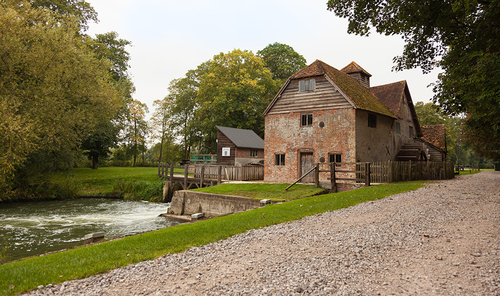
The Watermill at Mapledurham
James Webb leased the Mill and the lock in 1690 at £60 per annum. His son Daniel Webb took over from him in 1726 at a rent of £100. He was succeeded at a rent of £150 p.a. in 1747 (raised to £205 in 1776) by Thomas Antrum, who went bankrupt in 1784 over a debt of £100 to Myrtilla Mayhew. The tenure of these three millers covered the most profitable years for the Mill.
So important was the mill to the local community that as late as 1823 plans were drawn up to rebuild the Mill in classical style, by J. Phillips of Reading. This startling plan was considered seriously enough for detailed constructional plans to be drawn.
So important was the mill to the local community that as late as 1823 plans were drawn up to rebuild the Mill in classical style, by J. Phillips of Reading. This startling plan was considered seriously enough for detailed constructional plans to be drawn.
*The watermill is perhaps best known for its starring role in the 1976 film, The Eagle Has Landed, where the mill leat is the scene of the dramatic rescue of a local girl by a German paratrooper that results in the unmasking and ultimate failure of the raid.
*It is also the backdrop in the image on the cover of Black Sabbath (album), by the band of the same name.
information from www.wikipedia.org
Green Electricity at Mapledurham
Hydro-Powered Archimedes Turbine
In 2011 work commenced on the installation of Mapledurham's Archimedes screw thread turbine. The previous turbine which had been installed in the 1920s and was no longer operational was removed so that the new turbine could be placed in the same location. The screw thread has an approximate 20 year life span. By selling the electricity it produces to the National Grid, construction costs are covered in eight to ten years. The remaining time of production generates sufficient funds to enable Mapledurham Estate to replace historic buildings associated with the mill which have been missing since the early 1900s. The first phase was completed in six months, this included the installation of the turbine, reconstruction of the oak timbered footbridge and the reconstruction of the covered walkway. The timber buildings on the island have been incorporated in later phases.
Statistics
- Turbine has a 4 entry thread
- Turbine weighs 24.7 tonnes
- 8000 litres of water per second pass through the thread (enough water to fill 280 Olympic swimming pools every day)
- Produces approx. 500,000 KWH/year
- Fish can pass through the turbine unharmed
How It Works
The turbine's operating system is extremely efficient, a computer system controls the whole process. The computer receives information from a 'head sensor' located in the River Thames. The system uses this information to control the turbine's variable gearbox to enable the production of the maximum amount of electricity. In simple terms, as the river level and flow rate increases, the turbine's speed and power production will increase up to a set maximum. As the river level and flow rate decreases the turbine's speed and power production will decrease in order to maintain river levels. As long as the river flows, the turbine has the ability to produce sustainable electricity based on a principle which is 2000 years old.


